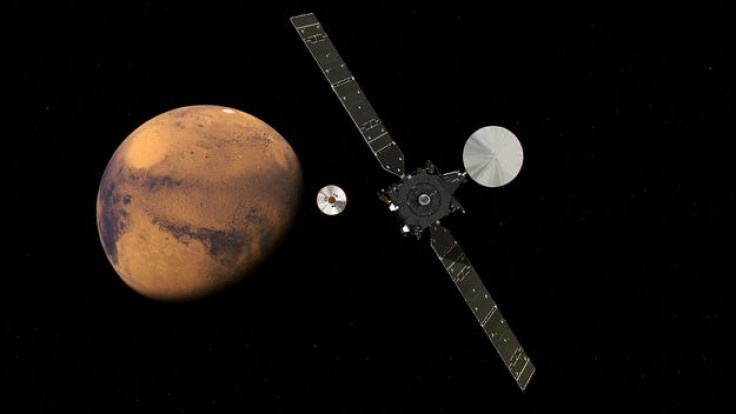ExoMars 2016 Landing: European Space Agency Spacecraft Arrives At Mars But Has It Landed?

A new spacecraft has entered the Mars atmosphere as part of the ExoMars mission—a collaborative effort between the European Space Agency (ESA) and the Russian Federal Space Agency. The spacecraft consists of two parts: a solar-powered Trace Gas Orbiter and the Schiaparelli lander.
On March 14, the orbiter and lander took off from the Baikonur Cosmodrome in Kazakhstan. After seven months and a 300-mile journey, the spacecraft entered the orbit of the red planet and should have landed on the surface of the planet on Wednesday, according to the ESA. After entering the orbit of Mars, the spacecraft's descent was confirmed at 17:12 CEST by the ESA with initial signals received by the Giant Metrewave Radio Telescope (GMRT) but no confirmation from the orbiter itself.
"This is not unexpected due to the very faint nature of the signal received at GMRT," writes the ESA. "A clearer assessment of the situation will come when ESA's Mars Express will have relayed the recording of Schiaparelli's entry, descent and landing."
Later, the ESA confirmed that a signal—which takes 9 minutes and 47 seconds to reach Earth from Mars—has been received from the Trace Gas Orbiter. That said, the status of the spacecraft has not been confirmed at the time of publication.
Signal received from the Trace Gas Orbiter @ESA_TGO at #Mars! More details to follow, stay tuned #ExoMars https://t.co/QUavuZ0wcL
— @ESA_ExoMars (@ESA_ExoMars) October 19, 2016
The goal of the orbiter, which has four instruments, will be to look for methane and similar trace atmospheric gases in the atmosphere of the red planet that could be “signatures of active biological or geological processes.”
“Trace gases in the martian atmosphere include methane, water vapour, nitrogen dioxide and acetylene,” explains the ESA on its website. “Although making up a very small amount of the overall atmospheric inventory, methane in particular holds key clues to the planet’s current state of activity.”
The lander, on the other hand, will test landing technologies that will help future missions to Mars after descending on the Meridiani Planum. Equipped with instruments to test for temperature, humidity, dust and wind, the lander has enough battery to last a few days.
The atmosphere and surface of Mars have other spacecrafts. NASA’s Opportunity and Curiosity are exploring the planet’s dunes and craters while three other spacecrafts—the Mars Reconnaissance Orbiter, the Mars Odyssey and the Mars Atmosphere and Volatile Evolution Mission—are orbiting the planet. The ESA’s Mars Express orbiter has also been in orbit since 2003 and India’s Mars Orbiter Mission has been in orbit since 2014.
This story has been updated to include the ESA's announcement that a signal has been received from the spacecraft.
© Copyright IBTimes 2024. All rights reserved.












